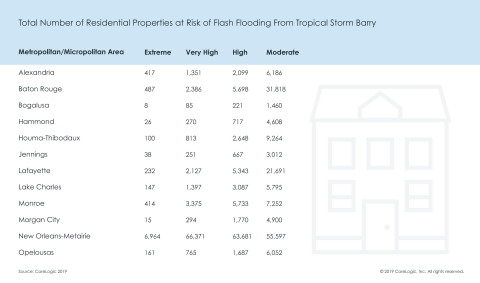—12 of 18 Metro and Micropolitan Areas At Risk of Flash Flooding—
IRVINE, Calif. — (BUSINESS WIRE) — July 12, 2019 — CoreLogic® (NYSE: CLGX), a leading global property information, analytics and data-enabled solutions provider, today released data analysis showing 339,480 homes in Louisiana are at moderate-to-extreme risk of tropical storm-driven flash flood damage from Tropical Storm Barry. Within the likely impacted metropolitan and micropolitan areas of Louisiana, 32.6% of homes are located within a Special Flood Hazard Area (SFHA). Homeowners are required to purchase flood insurance in these designated areas when their mortgages are backed by the federal government. CoreLogic hydrological analysis of flash flood risk in the likely impacted areas estimates that 26% of the homes have moderate-to-extreme flash flood risk.
This press release features multimedia. View the full release here: https://www.businesswire.com/news/home/20190712005454/en/

Total Number of Residential Properties at Risk of Flash Flooding From Tropical Storm Barry; CoreLogic 2019
In this analysis, CoreLogic data includes only single-family residential properties likely to be impacted by a lower category storm. Based on the National Oceanic and Atmospheric Administration’s (NOAA) forecast, Tropical Storm Barry is expected to make landfall sometime Saturday as a strong tropical storm or a weak Category 1 hurricane. While Tropical Storm Barry has not intensified into a hurricane yet, the focus of this analysis is centered around the rainfall and flooding component, which is expected to be the largest contributor to property loss.
The area along the Mississippi River, where concern is highest, appears to be able to withstand the amount of flooding expected. After Hurricane Katrina, $14 billion of levee and pumping capability improvements were made along the river; this event is not expected to cause catastrophic problems given these enhancements.
The accompanying table shows the total number of properties at risk of flash flood damage—from moderate to extreme—depending on storm size, rainfall and path.
Visit the CoreLogic natural hazard risk information center, Hazard HQ™, to get access to the most up-to-date Tropical Storm Barry data and see reports from previous storms.
Methodology
The CoreLogic Flash Flood Risk Score (FFRS) uses watershed hydrology and then extracts hydrologic properties from land information datasets (such as land slope, land imperviousness, soil infiltration, vegetation, land depression, and other factors), incorporating probabilistic characteristics of meteorological factors to simulate precipitation impact. All aspects of flash flooding factors are finally integrated to form an overall projection of flash flood risk. The model can pinpoint granular locations with high risk potential for flash flooding anywhere in the United States. FFRS provides flooding detail in areas where flooding resources are traditionally unavailable. More specifically, FFRS helps assess whether a flash flood component is identified, particularly in areas where flood zones are not mapped. FFRS fills in the flood risk assessment gaps where the previous focus was only on riverine and coastal flooding, and no initial flood insurance studies were ever conducted.
Source: CoreLogic
The data provided are for use only by the primary recipient or the primary recipient's publication or broadcast. This data may not be resold, republished or licensed to any other source, including publications and sources owned by the primary recipient’s parent company without prior written permission from CoreLogic. Any CoreLogic data used for publication or broadcast, in whole or in part, must be sourced as coming from CoreLogic, a data and analytics company. For use with broadcast or web content, the citation must directly accompany first reference of the data. If the data is illustrated with maps, charts, graphs or other visual elements, the CoreLogic logo must be included on screen or website. For questions, analysis or interpretation of the data, contact Chad Yoshinaka at Email Contact or Caitlin New at Email Contact. Data provided may not be modified without the prior written permission of CoreLogic. Do not use the data in any unlawful manner. This data is compiled from public records, contributory databases and proprietary analytics, and its accuracy is dependent upon these sources.
About CoreLogic
CoreLogic (NYSE: CLGX), the leading provider of property insights and solutions, promotes a healthy housing market and thriving communities. Through its enhanced property data solutions, services and technologies, CoreLogic enables real estate professionals, financial institutions, insurance carriers, government agencies and other housing market participants to help millions of people find, acquire and protect their homes. For more information, please visit www.corelogic.com.
CORELOGIC, the CoreLogic logo and Hazard HQ are trademarks of CoreLogic, Inc. and/or its subsidiaries. All other trademarks are the property of their respective owners.
View source version on businesswire.com: https://www.businesswire.com/news/home/20190712005454/en/
Contact:
Chad Yoshinaka
Corporate Communications
817-699-4572
Email Contact
Caitlin New
INK Communications
512-906-9103
Email Contact